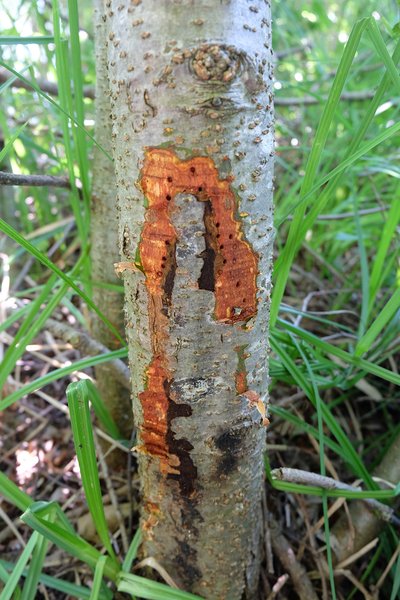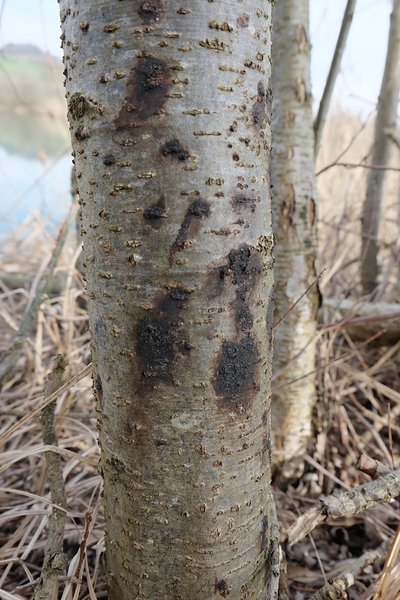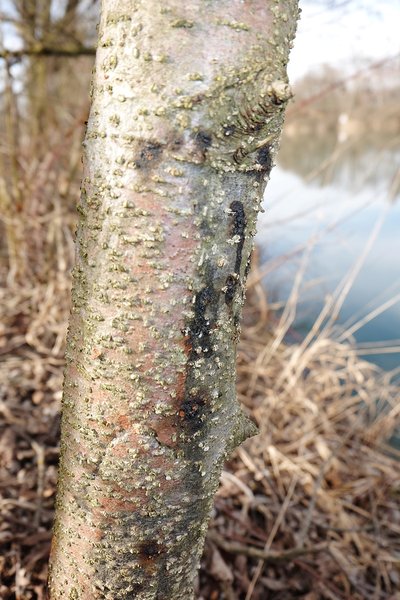Characteristics and symptoms
All species of the genus Phytophthora (Greek for “plant destroyer”) are plant pests and belong to a group of fungus-like organisms called oomycetes, also known as “water moulds”. Among the numerous Phytophthora species, three to date are known that exclusively attack alders: P. uniformis, P. ×multiformis, and P. ×alni. The latter is the most aggressive of the three pathogens and the main cause of a massive decline in alder stands in Europe. Until 2015, all three were considered variants of a single species.
All three species penetrate the tree either at the base of the trunk or via the root hairs, where they cause root rot. They then grow upwards on the trunk under the bark. When the bark is carefully peeled off, a tongue-shaped, reddish-brown staining is revealed underneath – the result of the death of the bark (necrosis). The tree responds to this with slime flux, i.e. the exuding of a tarry tree sap at the edges of the dying tissue. This causes orangey-brown to black rusty or tar-like spots in the lower trunk area.
As a result of the bark necrosis, the crown is no longer sufficiently supplied with minerals and water. Sometimes epicormic shoots also form on the trunk. These are probably an attempt by the tree to compensate for the damage in the crown area. Another stress reaction can be heavy flowering and cone production, also in young trees. The further the disease progresses, the more sparsely trees of all ages sprout in spring. The whole crown remains sparse, with its leaves small and yellowish throughout the growing season. First twigs die, then branches, and then, once the bark necrosis has spread all the way round the trunk, the tree itself finally succumbs.
The time it takes between infection and death may be a few months (in young trees), or also several years. However, infected trees are weakened even if the progress of the disease is slow, and they are thus susceptible to infestation by parasites that exploit weakness (e.g. wood-degrading fungi such as honey fungi [Armillaria]). As long as there is only slight damage to the bark, some trees can however recover from a Phytophthora infection by sealing off the destroyed tissue with callus growth, thus preventing the pathogen from spreading. Nevertheless, longitudinal cracks are often left at the base of the trunk.
Possibilities of confusion
In the case of a combination of crown symptoms, tar-like spots and necrosis rising up the stem, it can be assumed that the alder in question is infected by a species of the Phytophthora genus. In addition to the three species specialised on alders, the tree may also be infested by Phytophthora species with several host plants, such as P. plurivora or P. lacustris, some of which occur on the same sites. Only a genetic examination can thus bring certainty.
All the listed symptoms taken on their own can also have causes other than an infection with Phytophthora. Damage to the root tissue can thus also be the result of flooding. Likewise, the leaf-devouring alder leaf beetle (Agelastica alni) can cause similar damage to the crown, although this is rarely fatal for the tree. What is more dangerous is infestation by insects that damage the trunk or roots of the trees, especially if they bore feeding tunnels like the poplar and willow borer (Cryptorhynchus lapathi). This can lead to similar symptoms and also to the death of the tree in question. However, the boreholes and the material ejected by the beetle are good identification features. Sometimes prolonged periods of drought or severe frost can also lead to alder dieback, in the course of which cracks in the trunk or crown dieback can also be observed.
Biology and reproduction
All three parasites spread through water. Of central importance for the infection of further alders are the cells used for reproduction, called zoospores, which are released into the soil and surface or river water. These are not just transported passively by the current of the water, but can also swim actively like sperm thanks to their flagella. These allow them travel long distances in rivers, until they come across another alder.
They penetrate the tree usually either at the base of the trunk or via the root hairs. Flooding facilitates their penetration of the host plant as well as their spread, on the one hand because the roots may suffer injuries in the course of the inundation, which then serve as ports of entry for the pathogen, and on the other because it is also easier for the zoospores to reach natural openings such as aerial roots and lenticels on the trunk when the water level is higher.
Infections in alders far from the river are often due to the use of contaminated plant material from tree nurseries during afforestation measures. Infected soil particles may also be spread by vehicles deployed in water body maintenance or timber harvesting. Apart from timber transportation, the releasing of fish taken from infested waters may also contribute to the spread of the disease.
Distribution
The tendentially warmth-loving P. ×alni can now be found throughout western and central Europe, as far as Poland. The countries of the Balkan peninsula and those further east, such as Ukraine, Belarus and Finland, seem to have been spared so far. To date, only the cold-tolerant P. uniformis has been found in the Baltic states, Denmark and northern Sweden. All three species of Phytophthora occur in southern Sweden. However, P. ×multiformis occurs mainly at the quadripoint consisting of the Netherlands, Belgium, Germany and France, and in Great Britain.
In Switzerland, only P. ×alni is currently (2021) thought to occur, but it has only been detected with certainty once, on grey alder (Alnus incana) along the River Reuss near Rottenschwil (canton of Aargau) in 2008. The trees showed signs of crown dieback and slime flux. Individual alders with suspicious symptoms have been observed repeatedly since then, and particularly in 2014/2015, several sites with alders showing signs of slime flux were investigated. However, a further occurrence of P. ×alni has not yet been conclusively shown.
Ecology
It is probable that all species of the alder genus (Alnus spp.) can be infected by all three of the pathogens mentioned. In North America, P. uniformis has so far mainly attacked the Oregon alder (A. rubra). In Europe, the grey alder (A. incana) and especially the black alder (A. glutinosa) are most frequently affected, and increasingly also the Italian alder (A. cordata), which is native to the south. In the case of the green alder (A. viridis, syn: A. alnobetula), infection has so far been proven almost only in the context of experiments.
Plants growing on clay loam soils are particularly at risk. Alder dieback often occurs along watercourses and in carrs. Often it is a case of locations that are either regularly affected by flooding or where the groundwater level is naturally high or fluctuates considerably. The pathogen is less common in nurseries or forest gardens, but when it does occur, it often goes unnoticed without targeted testing, because it is often years before infected young plants show symptoms visible to the naked eye.
Alder dieback not only leads to timber harvesting losses, but also reduces the biodiversity of watercourses. Thanks to a symbiosis with certain bacteria, alders can absorb atmospheric nitrogen and thus make it biologically usable. Their nutrient-rich foliage is an important food supply for the fauna in the habitat. The alders themselves also serve as a habitat for many organisms, providing refuges for fish, for example. The roots of the alder help to stabilise the river banks, which is particularly important for flood protection.
Control measures
In cases of heavy infestation with alder Phytophthora, it may be advisable on used forestry sites to change to or add other tree species suitable for the site (for example bog birch, pedunculate oak, poplar and willow species). To prevent the pathogen spreading further, vehicles and machinery used in affected areas should be carefully hosed down after use. Any fish that are released should be taken from waters or aquacultures that are free of the pathogen.
In the case of afforestation in non-infested areas, natural regeneration is generally preferable to planting alders from tree nurseries, but in tree nurseries, inspections and targeted biosecurity management measures can ensure that no infected plants are used.
It only makes sense to fell infested trees if only individual trees are affected at a site. These must be removed with their roots and then burnt. In the case of newly infected alders in more severely affected areas, it may be worth cutting them back to the rootstock instead. This forces the growth of new shoots, which are usually healthy, and stilt roots often form, lifting the root collar out of the flood zone. Ideally, the tree thus remains alive, the copse is preserved for some time and further spread of the pathogen is prevented. The smaller the dead area of the trunk, the more successful this measure is likely to be. If the roots are infected, it is not likely to be successful.
Direct treatment of Phytophthora with chemicals it is neither efficient nor ecological, and it is also prohibited in the wild. It is however important to monitor the areas affected by alder dieback, some of which may well recover. The search for robust, resistant alder plant material is already at an advanced stage in the case of black alder. This gives us grounds for hope that alder dieback can at least be reduced through targeted breeding.
Where do I report it, and where can I ask for advice?
If alder Phytophthora is suspected, the Swiss Forest Protection Group should be contacted.
Translation: Tessa Feller



